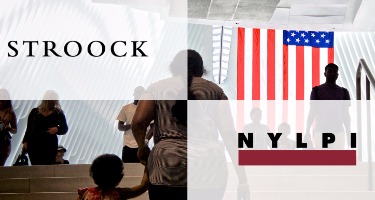Employers who want to temporarily hire a foreign national for a professional position have traditionally used the H-1B category. H-1B status is available for individuals who have a bachelor’s degree or equivalent and who will work for a U.S. employer in a job that requires a specific degree. The employer must pay the actual or prevailing wage, whichever is higher.
Unfortunately, many employers are subject to the H-1B cap, which limits the number of new H-1B numbers that can be issued each year to about 85,000. If U.S. Citizenship and Immigration Services (USCIS) receives more than 85,000 petitions in any year, it chooses which H-1B petitions it will adjudicate randomly. Thus, the H-1B is effectively a lottery system.
USCIS received more than 236,000 H-1B petitions in the first week of April 2016. Based on the number of petitions filed, most employers this year had only about a 35 percent chance of getting an H-1B petition accepted for adjudication. USCIS saw similar levels of submissions in 2014 and 2015. Due to the number of rejected petitions, the United States loses many highly qualified workers to other countries each year. As a result, many have called for legal reforms, including increasing the number of H-1Bs available each year, giving H-1B priority to graduates of U.S. schools, or eliminating the cap. However, Congress is unlikely to enact changes to the H-1B category any time soon.
Therefore, if rejected for an H-1B number, employers and potential foreign national employees must explore other immigration categories if the employment relationship is to come to fruition. Fortunately, several other immigration options exist for potential employees who lose the H-1B lottery. This article describes 11 such options.
F-1 Visa Options
Certain foreign students can work while having valid F-1 status. Optional practical training (OPT) allows international students to work both before graduation (pre-completion OPT) and after graduation (post-completion OPT). OPT employment must be related to the student’s field of study. Students apply for OPT work authorization after receiving a positive recommendation from their designated school official.
F-1 students can obtain up to 12 months of post-completion OPT after they graduate. F-1 students who have completed a degree in science, technology, engineering, or math (STEM) can qualify for an additional 24 months of OPT (a total of three years per degree). For example, a student with a bachelor’s degree in a STEM field may work for three years after receiving the degree. If the student later obtains a master’s degree in a STEM field, he or she can qualify for an additional three years of OPT. STEM employers must be enrolled in E-Verify for a student to qualify for the STEM extension.
While a student is in OPT, an employer may file an H-1B petition. That means that for F-1 students in STEM fields, an employer may have up to three chances of winning the H-1B lottery, depending on when STEM OPT ends for the student. Moreover, if an employer wins the H-1B lottery and an H-1B petition is approved for the student starting October 1, but the student’s OPT expires before that date, he or she can stay and work in the United States until October 1 so that there is no gap in status or work authorization. USCIS calls this the H-1B cap gap extension.
Cap-Exempt H-1B Visa Options
One of the most desirable alternatives to the H-1B is, in fact, the H-1B! By that we mean an H-1B petition filed by a cap-exempt employer. Cap-exempt employers include colleges and universities, non-profit entities affiliated with or related to a college or university, and non-profit and government research organizations. Petitions filed by third-party private employers may also be considered cap-exempt if the beneficiary will perform the majority of his or her duties at an H-1B qualifying employer and if those duties will further the primary purpose of the H-1B qualifying employer.
Cap-exempt colleges and universities include those institutions that offer at least a two-year degree program, are public or non-profit in nature, and are accredited or have pre-accreditation from the U.S. Department of Education. Non-profit entities are those approved by the Internal Revenue Service as 501(c)(3), (c)(4), (c)(6), or for research or educational purposes. An affiliated or related non-profit entity is one that is owned, operated, or controlled by a college, university, or attached as a member, branch, or cooperative to a college or university.
Determining whether an entity is a qualifying college, university, non-profit, or government research organization is generally a straightforward analysis. Determining whether a third-party employer or entity affiliated with a college or university qualifies as a cap-exempt employer is more complicated, in part because of inconsistent USCIS adjudications and narrow definitions of “related” and “affiliated.”
To be deemed a cap-exempt petitioner, a third-party private employer must satisfy the “nexus requirement,” meaning that “there is a logical nexus between the work performed predominantly by the beneficiary and the normal, primary, or essential work performed by the qualifying institution.” This requirement has proved troublesome in certain cases. For example, a scientific researcher might be employed on-site at a college or university to perform research related to developing a particular therapeutic drug rather than to educate students, which is a normal mission of a college or university.
Moreover, USCIS also requires an employer-employee relationship between the third-party petitioner and the beneficiary. More specifically, the employer must have the right to control the beneficiary’s work. This can be problematic if the college, university, or affiliated entity directs the type and amount of work performed by the beneficiary rather than the third-party employer.
Furthermore, USCIS applies narrow definitions to the terms “affiliated” and “related,” which reduces the number of non-profit entities that may qualify as cap-exempt. USCIS’ current definition excludes entities that are affiliated with colleges or universities by written agreement. A formal, written agreement is an extremely common method of affiliation between colleges, universities, and outside entities. USCIS has proposed regulations that would include such types of affiliations within the definition of “affiliated.” However, as of the date of this writing, these regulations have not been finalized.
Thus, a number of potential minefields exist when attempting to qualify an employer as cap-exempt. Nevertheless, obtaining employment with such an entity is a viable alternative to a cap-subject H-1B, in particular because concurrent H-1B petitions are permissible. In other words, a beneficiary can first obtain H-1B status through approval of a cap-exempt H-1B. Then a second cap-subject employer can file an H-1B petition for the same beneficiary. Though the second H-1B petition would normally require a cap number, one is not required under these circumstances.
Additionally, there are no restrictions regarding the amount of time a beneficiary must work at each employer. He or she might work part time for the cap-exempt employer and full time for the cap-subject employer. Further, even if the beneficiary’s employment with the cap-exempt employer ends, it is possible that he or she may continue to work for the cap-subject employer until the period of stay expires. At that point, the cap-subject employer would have to submit a new H-1B petition to try and capture a cap number.
Accordingly, in the absence of an H-1B cap number, a beneficiary should consider whether cap-exempt employment, even in a part-time capacity, might be possible.
L-1 Visas for Intracompany Transferees
The L-1 category can be an excellent alternative for individuals who cannot obtain an H-1B number in the lottery, as there is no annual quota for L-1s. The main caveat is that the L-1 category requires qualifying work abroad before applying for L-1 status.
The L-1 category is reserved for multinational managers, executives, and individuals with specialized knowledge. To qualify as an L-1, an individual must have been employed abroad for at least one of the three years preceding his or her admission to the United States in a managerial, executive, or specialized knowledge capacity for a qualifying organization. Additionally, the qualifying organization must be transferring the individual to a related entity in the United States to work in a managerial, executive, or specialized knowledge capacity. A potential L-1 beneficiary does not have to work in the same capacity for the U.S. employer as the foreign employer. For example, he or she could work as a manager overseas but as an executive in the United States.
Managers and executives are typically fairly easy to identify, as they exercise wide discretion in decision-making and oversee important company functions or employees. Specialized knowledge employees have valuable knowledge of a company’s products, services, and/or processes, among other things.
USCIS tends to adjudicate all three L-1 types fairly harshly. For example, USCIS often requests for evidence of the number of employees that the potential L-1 supervises.
For L-1 purposes, the U.S. employer must be a branch, affiliate, parent, or subsidiary of the foreign employer. Affiliated entities include subsidiaries owned and controlled by the same parent as well as entities owned and controlled by the same group of individuals in approximately the same proportion.
If the U.S. employer has existed for less than a year, the L-1 petition is deemed a “new office L” and is subject to more stringent evidentiary requirements, including providing evidence of a specific site for operations as well as the amount of investment into the company.
In contrast with H-1B requirements, qualifying L-1 employment is not reserved for individuals with a bachelor’s degree or higher in a specific specialty. It is, however, limited to individuals who have filled an important role within the foreign employer and will continue to do so for the U.S. employer.
L-1s are initially approved for up to three years and can receive extensions.
L-2 spouses may apply for independent work authorization. This sets up an interesting option, whereby an individual in L-1 status may allow his or her spouse to work for a company when an H-1B does not exist.
Country-Specific Visa Options
• TN Options for Citizens of Canada and Mexico
The TN classification is well-suited for Canadian and Mexican citizens seeking to work in one of the professional occupations listed in the North American Free Trade Agreement (NAFTA). Professionals in various fields (including information technology, engineering, finance, marketing, and consulting) frequently use the TN to work in the United States. The TN is also quick to obtain. Canadian TN applicants just need a brief letter and supporting evidence describing their employer, position, and qualifications. They generally apply at the U.S.–Canada border. Mexican TN applicants need the same information, but must schedule an appointment to apply at a U.S. consulate.
TNs are ideal because the fee is minimal (compared to thousands of dollars to file an H-1B petition), there is no annual limit on the number of TNs, and individuals receive a work permit for up to three years that can be renewed pretty much indefinitely.
An “employer” under NAFTA can be either a U.S., Canadian, or Mexican company that has a written agreement to provide professional services to a U.S. entity. For example, a Canadian consulting company can be the “employer” of a Canadian TN beneficiary, provided he or she is working in the United States pursuant to a written agreement between the Canadian employer and a U.S. entity.
Some NAFTA occupations require at least a bachelor’s degree to qualify. Other positions require a specific degree or post-secondary diploma plus experience (e.g., interior designer, hotel manager, or computer systems analyst).
NAFTA allows an applicant possessing a degree in an allied field to qualify for TN status under certain circumstances. For example, a Canadian professional may seek to fill a graphic designer position for a U.S. company. However, she has a visual arts degree, not a graphic design degree. The visual arts degree is not specifically listed in the NAFTA occupations. However, an evaluation of the person’s transcript may disclose classes taken where the knowledge gained could be used to perform graphic design work. Consequently, a TN application could be prepared and presented as a graphic designer.
• H-1B1 Visas for Citizens of Chile and Singapore
The United States has free trade agreements with Chile and Singapore that allow citizens of those countries to work in the United States under special H-1B rules. The substantive requirements for an H-1B1 visa are the same as for a normal H-1B visa. H-1B1 applications can be made within the United States or at a U.S. consulate or embassy. Like the E-3 described below, H-1B1 employers must first obtain a labor condition application from the U.S. Department of Labor. Admission on an H-1B1 visa is for one year. H-1B1 status can be renewed in yearly increments. Unlike the H-1B category, there is no limit on time spent in H-1B1 status.
Up to 1,400 Chileans and 5,400 Singaporeans can obtain H-1B1 visas each year. Those country-specific caps have never been reached. Thus, an employer who has a potential professional employee from Chile or Singapore should consider this alternative to avoid the normal H-1B cap.
• E-3 Visas for Citizens of Australia
If a potential employee is an Australian national, the E-3 category is potentially the best alternative to an H-1B. In fact, under these circumstances, an employer should consider E-3 instead of a cap-subject H-1B because the E-3 requirements are virtually identical to H-1B requirements, there is no cap, and there is no limit on the length of time an individual can remain in E-3 status. Also, the definition of Australian national is broad enough to include individuals who were not born in Australia but possess an Australian passport. Other benefits include work authorization for spouses of E-3s.
E-3 petitions must satisfy four criteria: (1) the beneficiary must be an Australian national who (2) has an offer of employment in the United States, (3) possesses the requisite credentials for the job, and (4) will fill a specialty occupation position. As such, E-3 petitions are subject to the same scrutiny and potential challenges associated with qualifying a position as a specialty occupation for H-1B purposes. A specialty occupation is one that requires theoretical and practical application of a specialized body of knowledge and a bachelor’s degree or higher in that particular specialty.
Individuals can apply for E-3 status with USCIS or at a U.S. consulate or embassy abroad. Before such application, however, E-3 employers must obtain a certified labor condition application from the DOL. E-3s are granted a slightly shorter period of admission than H-1Bs, as petitions are approved in two-year increments rather than three. But there is no limit on the number of E-3 extensions that a petitioner may obtain for a beneficiary, which contrasts with the maximum six years that a beneficiary may remain in H-1B status. Therefore, an employer who wants to keep a beneficiary in a position long term may prefer the E-3 over the H-1B.
Downsides to the E-3 category include lack of premium processing and work authorization during pendency of an extension of status petition. As such, if submitted to USCIS, E-3 extension applications should be submitted at least six months before the current E-3 expires. Additionally, it may behoove an E-3 applicant to make his or her initial and/or subsequent E-3 applications abroad at a U.S. consulate or embassy since work authorization depends on the approval of the application instead of filing.
O-1 Visas for People with Extraordinary Ability
Unlike the H-1B category, the O-1 category lacks annual numerical restrictions and salary requirements. There are no prior employment requirements, like L-1s. O-1 status is not restricted to Canadians or Mexicans, like TN. However, O-1 applicants must demonstrate extraordinary ability in their field—meaning they are at the top of their field.
To establish extraordinary ability, an individual must either demonstrate a one-time international achievement—such as an Olympic medal, Oscar, or Nobel Prize—or satisfy at least three of the following eight criteria:
• Receipt of lesser nationally and internationally recognized prizes or awards for excellence in the field of endeavor;
• Membership in associations in the field that require outstanding achievements of their members, as judged by experts in the field;
• Published materials about the individual in professional or major trade publications, or appearance/published materials about the individual in other major media;
• Participation, either individually or as part of a panel, as a judge of the work of others in the field (including requests to serve as a reviewer/referee for articles to be published, invitations to serve on discussion and advisory panels, etc.);
• Original scientific, scholarly, artistic, athletic, or business-related contributions of major significance in the field;
• Authorship of scholarly articles in the field, as published in professional or major trade publications or in other major media;
• Serving in a critical or essential capacity for organizations or establishments that have a distinguished reputation; and/or
• Commanding a high salary or other significantly high remuneration for services, as compared to others in the field.
Initial O-1 petitions are approved for up to three years. There is no limit on O-1 extensions, which are granted in increments of one year at a time if the extension is with the same employer and for the same event. However, the O-1 can be extended for a three-year period if it is for a different employer and a different event.
The O-1 standard is high. As such, it is not usually the first option to consider for someone who fails to get an H-1B number. But for those with significant, documented experience or academic credentials (such as a PhD graduate, postdoc, or junior researcher), the O-1 is worth considering if an H-1B does not materialize.
E-2 Visas for Treaty Investors Employees
The E-2 category is most commonly known for individuals who invest a substantial sum of money in a U.S. business. However, E-2 status is also available to individuals who will serve in an executive, supervisory, or essential capacity for a business.
E-2 status is only available to applicants from countries that have investment or similar treaties with the United States. Over 40 countries have E-2 treaties with the United States, but certain populous countries like Brazil, China, India, and Russia do not. To qualify for E-2 status, the employee must have the same nationality as the employer and thus the treaty country. If a business is at least 50 percent owned by persons with the treaty country nationality, the business is considered to possess that nationality for E-2 purposes.
Similar to L-1 executives and managers, E-2 executives and supervisors typically exercise wide control and responsibility over the company or an important component of it. They usually determine company policy and/or oversee high-level company operations. E-2 essential employees are comparable to L-1 specialized knowledge employees. However, prior overseas employment with the company is not required. Rather, E-2 essential employees can be employed for short-term training purposes or long term if they have qualifications that make them essential to efficient operation of the company.
Initial E-2 applications are best made at a U.S. consulate, though they can be made with USCIS. E-2 visas are generally issued for five years, with beneficiaries admitted for two years at each entry during the validity of the visa. E-2 status can be extended indefinitely.
An E-2 spouse is eligible for work authorization. This may provide creative options for rejected H-1B applicants. For example, the United States does not have an E visa treaty with India. But if an Indian employee is married to a treaty citizen (e.g., the United Kingdom), the spouse may qualify for E-2 status. If so, the Indian employee can obtain work authorization through his or her spouse.
Trainee Visas: J-1 and H-3
The J-1 classification is used for a variety of purposes, ranging from au pairs to exchange students to professors. One J-1 subcategory allows eligible international professionals or interns to receive training at U.S. companies for a select length of time. J-1 trainee programs are generally for 18 months, while intern programs are even shorter (12 months).
In addition to the relatively short period of work authorization, J-1 classification poses several other challenges. Most importantly, the J-1 applicant must be placed at the employer through a designated sponsor. Also, some J visas require a nonimmigrant to leave the United States for two years before obtaining an H-1B visa or permanent residence. A waiver of the two-year rule is sometimes possible.
Spouses of J-1s can obtain independent work authorization. That may create opportunities for some spouses who have been rejected in the H-1B lottery.
The H-3 category also allows foreign nationals to receive training. An H-3 employer must meet several requirements, including having a formal training plan, proving that the proposed training is not available in the foreign national’s country, showing that the trainee will not work unless such work is incidental and necessary to the training, and ensuring that any productive employment will not displace a U.S. worker. These requirements make the H-3 category unattractive or impossible for many employers. Employers who can meet these requirements, however, may want to consider this category for rejected H-1B applicants. If approved, an H-3 will be admitted for the duration of the training program up to a maximum of two years.
Green Card Options
Most green cards take a year or longer to obtain, so they may not immediately offer a solution for someone who is rejected in the H-1B lottery. However, some green card applicants, such as spouses of U.S. citizens, can obtain an interim work permit while their applications are pending. USCIS currently takes about three months to process those work permit applications. Thus, if a rejected H-1B employee has married a U.S. citizen, ask whether he or she has a work permit to allow them to continue working.
Conclusion
If a potential employee fails to get through the H-1B lottery gauntlet, do not abandon hope. Consult an experienced immigration lawyer to explore all options. For example, a rejected H-1B applicant may be able to work through a spouse or have enough time on his or her F-1 OPT to apply in the H-1B lottery again next year. If the employer has an overseas office, perhaps the individual can work there for a year and then transfer back to the United States on an L-1 visa.
There may not be an easy solution for all denied H-1B applicants. But with creativity and planning, an answer can often be found.
Copyright © 2017 by Kristal Ozmun and Stephen Yale-Loehr. All rights reserved.
-----------------------------------------
Kristal Ozmun is a partner in Miller Mayer’s immigration practice group. Ms. Ozmun focuses her practice on employment-based immigration with a unique specialization in the EB-5 preference category. Ms. Ozmun has written and lectured on EB-5 topics for multiple organizations, including AILA, IIUSA, and ILW.
Steve Yale-Loehr is an attorney of counsel in Miller Mayer’s immigration practice group as well as a professor of immigration practice at Cornell Law School. He brings 30 years of immigration law experience in advising corporate and individual clients on a broad array of family- and employment-based immigration matters.
































